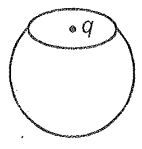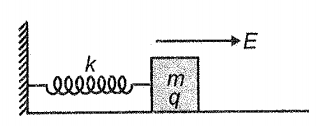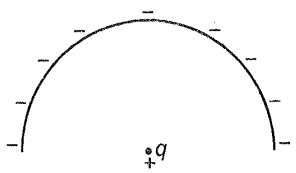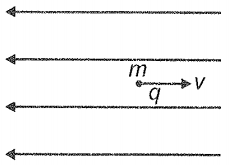Two charges \(2~\mu\text{C}\) and \(8~\mu\text{C}\) are separated by \(6~\text{cm}.\) The neutral point is at:
1.
\(4~\text{cm}\) from \(2~\mu\text{C}.\)
2.
\(2~\text{cm}\) from \(2~\mu\text{C}.\)
3.
\(2~\text{cm}\) from \(8~\mu\text{C}.\)
4.
\(3~\text{cm}\) from \(8~\mu\text{C}.\)
At what distance from the larger point charge the electric field is zero?

1. 4 cm
2. 11 cm
3. 22 cm
4. 40 cm
A point charge q is kept at the center of the circle formed by cutting a spherical shell by a plane as shown. The electric flux linked with the remaining surface of the shell is

1.
2.
3.
4.
In the diagram shown below the block has charge q and is attached at one end of the light spring. The surface is smooth and horizontal and the spring is in its natural length. If the electric field E is switched on, the maximum elongation in the spring will be

1.
2.
3.
4.
A point charge +q is kept at the center of the curvature of thin semicircular wire of length l as shown. The wire has uniformly distributed charge -q on it. The dipole moment of the system is

1.
2.
3.
4. Zero
A conducting body has a cavity in its as shown in the diagram below. A point charge q is held at the centre of the cavity. The electric flux linked with the closed surface S (shown dotted) is

1.
2.
3.
4. Zero
A neutral bubble made of soap solution has radius R. If some negative charge is given which gets distributed uniformly on the surface of the bubble, the radius of the bubble becomes R' then
1. R' > R
2. R' = R
3. R' < R
4. R' = 0.5 R
A large non-conducting sheet S is given a uniform charge density. Two uncharged small, metal rods A and B are placed near the sheet as shown in the following diagram. Choose the incorrect option:
1. S attracts A.
2. S attracts B.
3. A attracts B.
4. S repels A.
An electric dipole is placed at the centre of a sphere. Which of the following statements is correct?
| 1. | The electric flux through the sphere is zero. |
| 2. | The electric field is zero at every point on the sphere. |
| 3. | The electric field is zero at every point inside the sphere. |
| 4. | The electric field is uniform inside the sphere. |
A particle with charge +ve and mass m is projected with velocity v in the opposite direction of a uniform electric field E as shown in the figure in a gravity-free space. After what time the velocity will become -v?

1.
2.
3.
4.







